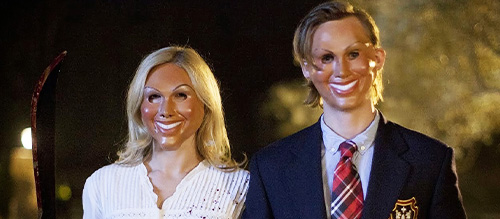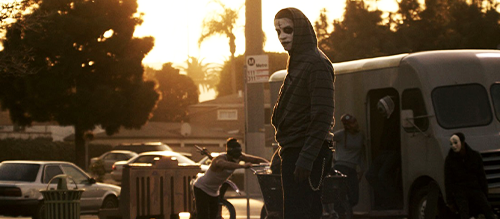Purge Movies Ranked
The Purge series is an alternate history, thriller-horror sensation, grossing massive amounts off relatively small budgets. The series has five films as well as a two-season television show. The films vary in their specifics, but the overarching concept is that one night a year Americans are allowed to commit any crime, except for a select few like using explosives and killing certain politicians (though it isn’t clear how these are actually enforced since there are no emergency services). The justification is that crime and poverty go down, though exactly how isn’t touched on in the films beyond saying that it does, and there’s little by the way of scepticism regarding any of the claims. In The Purge, absolute freedom to do whatever you want is massively underutilized, as murder seems to be the primary expression of one’s freedom despite the ability to commit any crime. Where’s a plot about factories who crank out products in violation of USDA regulations, or women trying to get an overnight abortion at a Texas women’s clinic only open on Purge Night?
There are notions of wealth gap, racism, and the US government’s tendency to punish minority communities to enrich the majority, but they feel shallow in the beginning of the series. The initial dystopian premise is more of a way to spice up a home invasion film (and, later, straight up action movies) than a scathing critique of… anything, really. In an interview with Bloody Disgusting, director James DeMonaco discussed watching American news versus news in Europe or Canada, and he noticed trends in American violence and how this is portrayed in media globally. But are the films a mirror, or are they yet another media outlet simply glorifying and distorting the international view of America for profit?
The overall perspective on American government and its populace is also rather perplexing. The New Founding Fathers are a mishmash of populism and utopian idealization – reading through the film’s 2013 site, filmgoers can learn that the Purge was brought about based on scientific research and the event’s positive effects on human behavior throughout the rest of the year. One look at this in 2021 and the idea of a competent group overtaking the US government and implementing ideas based on scientific research seems absurd, much less the idea that Americans would accept universal healthcare. People in the film adapt way too well to the idea that purging is a “right” given to them by God, and don’t spend enough time whining about functionally not being able to go outside or being forced to wear a mask by a weirdo trying to act like a villain in a movie. Though the movies do improve in this regard, the change came reactively rather than proactively.
Whether one views the Purge films as true critiques that adhere to an interesting lore or just a romp to endure while munching on popcorn, these movies do have a clear order of “best-to-worst” which can be seen here in The Film Magazine’s latest edition of Ranked: the Purge Movies Ranked.
Follow The Film Magazine on Twitter.
5. The Purge (2013)

The Purge series’ initial film is undoubtedly its weakest. Starring big names like Ethan Hawke and Lena Headey, The Purge follows a wealthy family who believe themselves to be secure in their home on Purge Night. This all changes when the family’s son, in defiance of his family’s wishes, harbors a strange man in their home.
The Purge would be just another home invasion movie if not for the premise. While there are some discussions about the morality of the Purge, the discussions are flimsy at best, invoking standard nationalist arguments about “muh freedoms” in a way that convinces no one inside or outside the diegetic space. There is no real insight into the larger world beyond the house outside of these brief conversations (or a visit to the film’s viral website), causing The Purge to feel as insulated as the characters themselves.
A major selling point of The Purge is the bad guys in creepy masks looking into security cameras, which isn’t all that scary. It stretches the bounds of believability when the main bad guy is so camp – imagine the background extra bad guys following this person around and putting up with their shenanigans when they should really just leave this house alone and go murder some other people (not to mention that the rich-on-rich crime isn’t particularly compelling). The other performances in the film are serviceable but fail to wow, and the tension and violence is mediocre at best.
It’s also clear from this film that criticism of violence in American culture falls by the wayside when the violence becomes the goal of the movie itself. We’re here to see people kill or be killed, which is antithetical to the film’s core idea that this media-fueled violence is a fundamental issue in America. This obsession with showing how ritualistic and nationalistic Americans are serves more as set dressing than a philosophical hypothetical for the film to really explore. It’s a standard home invasion flick with a premise that only matters because it spawned a franchise.
4. The Purge: Anarchy (2014)

Here’s the plot description for The Purge: Anarchy from IMDb:
Three groups of people intertwine and are left stranded in the streets on Purge Night, trying to survive the chaos and violence that occurs.
And that’s really all these characters are – unspectacular people running from one action set piece to the next. It’s only a step up from the first film because it offers a wider scope, placing us right in the thick of the worst night of the year. It features riveting exchanges like:
“What are you looking at?” “Nothing. Just, you know, stuff.”
The most interesting character in the film is a guy who is on a mission to murder the man who killed his son in a drink driving accident, and that’s exactly the sort of personal vendetta that could make for an awesome movie. Instead, the guy keeps getting distracted by video game side quests, rather than conflicts that actually relate to his character in any way. There’s also a very unsurprising narrative twist.
One of the major set pieces is a silent auction that gives rich people the opportunity to buy someone to kill, which seems like a cool plot for a completely different movie. Here, it’s crammed into the end of the narrative so that there’s something big to top all the other violent sequences of the film, and it doesn’t even get around to the Hostel portion of the event.
While The Purge: Anarchy may effectively depict the anarchy in the streets during the Purge, it doesn’t tell a compelling story or offer anything unique beyond its general premise. Fans of action movies would be better off watching any other action movie that doesn’t bear the conceit of being something more than yet another action movie.

